
views
Pulling off a Paper Caper
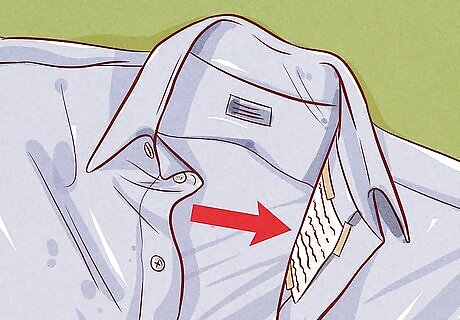
Tape a small cheat sheet to the inside of your shirt. While getting dressed on the day of your exam, pick out an oversized shirt with a low, loose neckline. Jot down your notes on a note card or half-sheet of notebook paper, then use a couple strips of tape to hold it in place on the inside of the front of the shirt. You should be able to see it easily when you lean over. For this tactic to work effectively, your handwriting needs to be big enough to make out at a glance.
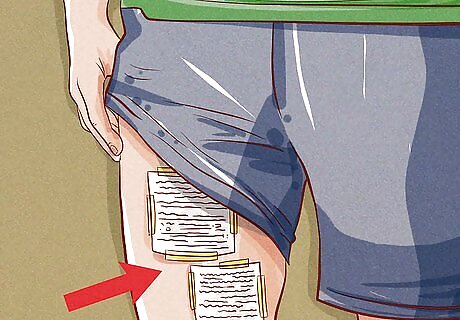
Hide larger crib sheets under a pair of shorts. Record as much information as you can on a piece of paper. Then, tape the paper to your upper thigh and pull on a pair of long shorts. When you get to a question you don’t know the answer to, slide the leg of your shorts up subtly to steal a peek at your notes. If you'd prefer to wear a skirt or dress, you can also get away with this one by using pantyhose to keep the paper pressed face-up against your leg and covering it with the hem of the garment. Concealing your notes in your clothing is one of safest methods of cheating that there is, as it’s unlikely that your teacher will ask you to remove something you’re wearing.
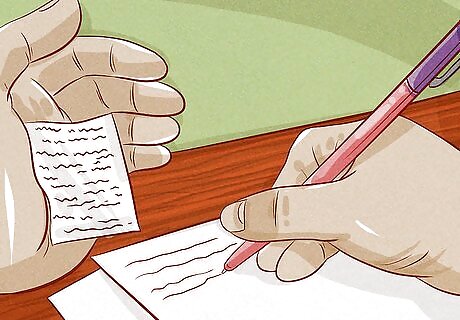
Make a pencil rubbing of your notes on the sly. Just before your test, copy a few helpful hints onto a fresh sheet of paper, with a second sheet lying directly underneath. Toss the top sheet in the trash and sneak the apparently-blank bottom sheet into your exam with you. Rubbing the edge of a pencil over the impressions in the paper will cleverly reveal what’s been etched into it. While transcribing your notes, it’s important to bear down hard enough with your pen or pencil to leave deep grooves in the surface of the bottom sheet. Rather than scribbling feverishly, pretend you’re simply doodling on the blank sheet to avoid attracting unnecessary attention.
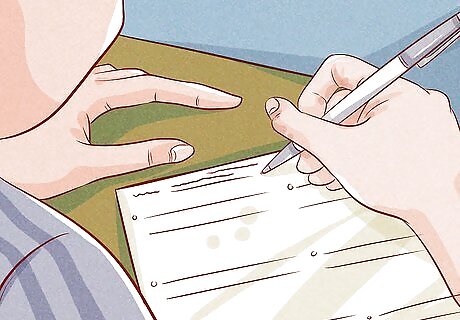
Revise your answers quickly after your test has been returned to you. This ruse is a bit of a gamble, but it doesn’t require anything but your own graded exam to pull off successfully. As soon as you get your test back, add to or alter a few of your incorrect answers and tell your teacher that you think they made a mistake. With any luck, they’ll take a second look and give you the benefit of the doubt. Make sure you revise your test with the same type of pen or pencil you originally used to supply your answers. Otherwise, it will be obvious what you’re trying to do. Since this method requires you to wait until your test has already been scored, it may be best reserved as a last-ditch effort to improve a failing grade.Tip: The old revise-and-return con works best on math and science exams, where a correct answer could plausibly go unnoticed in a jumble of numbers and equations.
Hiding Notes in Ordinary Classroom Accessories

Slip a note card under the cover of your calculator. For math tests where calculators are allowed, one easy trick is to whip up a cheat sheet and stash it inside the device’s removable cover. All you have to do is put the cover on the backside of the calculator, slide it up enough to see what you’ve written, then slide it back down whenever your teacher is nearby. If trying to maneuver a note card in and out of sight seems too risky, you can also write directly on the calculator in pencil. Since the pencil markings and calculator are both dark, your notes will only be visible from a certain angle. Don’t forget that you can program formulas and equations right into most graphing calculators. This is such an obvious advantage that it can hardly be considered cheating.
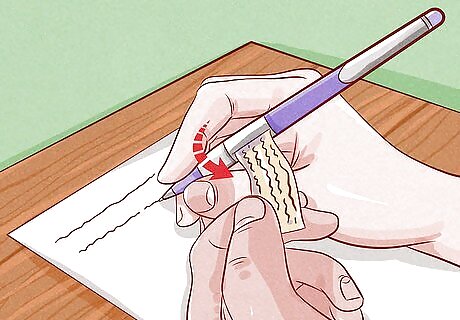
Smuggle a cheat sheet into your test in a mechanical pencil. Write down whatever information you need to survive your exam on a slip of paper. Roll the paper into a thin tube and funnel it into the chamber of a mechanical pencil, preferably one that isn’t see-through. When it comes time to retrieve your notes, just act like you’re replacing the lead in the pencil. Alternatively, you can format your notes lengthwise on a long, thin strip of paper, place it inside a transparent pencil, and look into the body of the pencil at the cheat sheet whenever you get stumped.
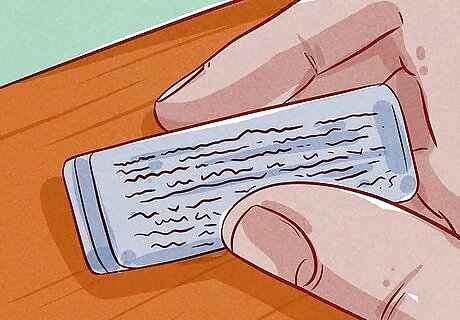
Write out formulas and single pieces of info on a large eraser. Most erasers won’t be big enough to hold a lot of text (unless your handwriting is tiny), but they’re the perfect size to jot down key details that you’re prone to forgetting. You can easily fit a few formulas, dates, names, or shorthand sentences on the face of an ordinary rubber eraser. Flip your eraser over while your teacher is making their rounds, and try not to be too obvious about what you’re staring at.Tip: If you’re in danger of being discovered, rub the eraser against the top of your desk for a few seconds to literally erase any evidence of wrongdoing.
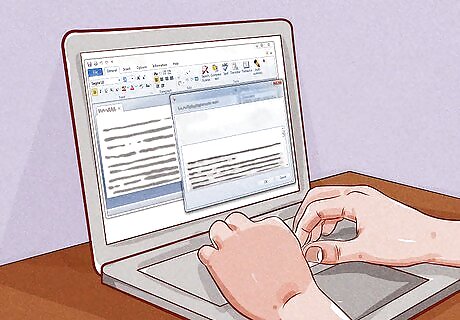
Create an offline cheat sheet in a word processor file. Computers are a common sight in classrooms nowadays, but many schools don’t permit internet use during testing periods. Despite this obstacle, you can still take advantage of the technology at your fingertips by drafting up a detailed cheat sheet in a word processor file and pulling it up periodically while you’re typing up that essay you didn’t study for. Assuming you have internet access and lax teacher supervision, cheating is as simple as starting a private Facebook group with a handful of trustworthy classmates and sharing your answers with one another. Some schools use special browser settings to keep students from navigating away from the current screen once they’ve loaded an online exam. If that’s the case, you’re out of luck.
Sneaking Answers Using Other Means
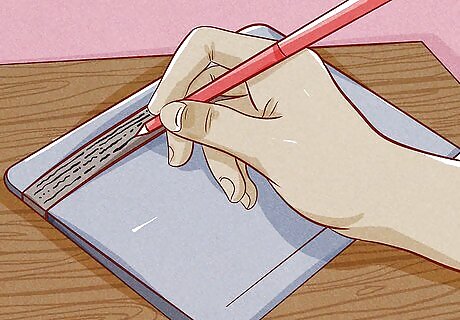
Turn a rubber band into a covert cheat sheet. Loop a thick rubber band around a book and write on it while it’s stretched out. Your writing will just look like a random design once it returns to its original size. Wait until no one is looking, then give the rubber band a tug and watch your notes magically appear. Make sure you write your letters nice and small. That way, no one will be able to tell what they are until you stretch out the rubber band.
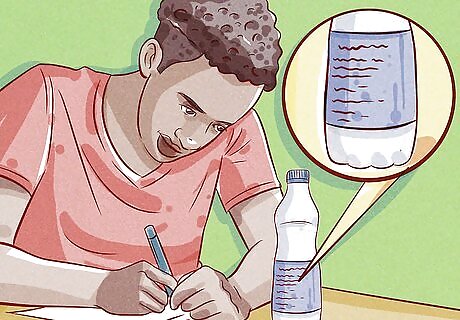
Print your notes on a water bottle label. Remove the label from a bottle of water and scan it onto your computer. Open the file in an image editor and replace all the visible text with crib notes. Once you’re done, print out the fake label and attach it to the bottle using a dab of glue. If you don’t have a scanner or printer at your disposal, you can write on the inside of the label, then reattach it using a dab of glue. To make the most of the space you have, try to cover as much of the label as possible, including the areas where the product slogan, serving info, and ingredients list would usually go.Tip: Your notes will have the least chance of attracting suspicion on labels that feature lots of text.
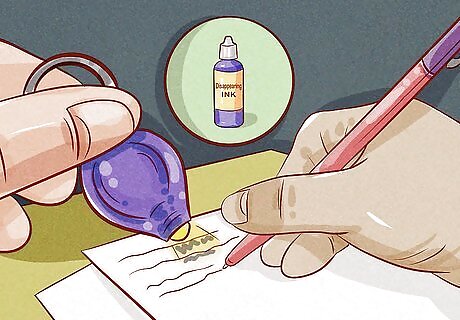
Write down the answers to the test in invisible ink. Either scrawl the answers directly onto your desktop (if you have an assigned seat) or put them on a “blank” sheet of paper and keep it out during the test. They’ll glow brightly when illuminated with UV keychain light, but will remain unseen to anyone passing by the rest of the time. You can buy invisible ink online or at most craft stores for around $10 a bottle. Another option is to shop around for a set of invisible ink pens. These often come with handy UV mini-flashlights built in.
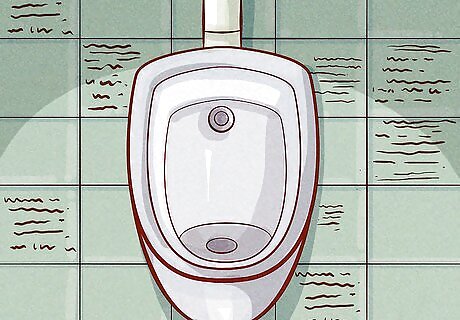
Graffiti a bathroom stall with test answers. Sometime before your test, make a list of any items you don’t understand and tag them on the wall of one of the stalls in the bathroom. If things go south during the exam, tell your teacher you urgently need to use the restroom and slip away to consult your secret treasure trove of knowledge. Leave your answers in out-of-the-way places where someone will be unlikely to spot and erase them. It’s also a good idea to use pencil or washable marker to avoid getting in even more trouble if you happen to get busted.



















Comments
0 comment